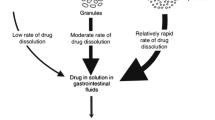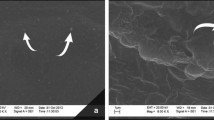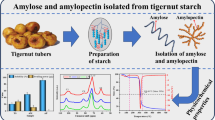Abstract
In the present work, an attempt has been made to screen Prosopis africana seed gum (PG), anionic polymer for extended release tablet formulation. Different categories of drugs (charge basis) like diclofenac sodium (DS), chlorpheniramine maleate (CPM), and ibuprofen (IB) were compacted with PG and compared with different polymers (charge basis) like xanthan gum (XG), hydroxypropyl methyl cellulose (HPMC-K100M), and chitosan (CP). For each drug, 12 batches of tablets were prepared by wet granulation technique, and granules were evaluated for flow properties, compressibility, and compactibility by Heckel and Leuenberger analysis, swelling index, in vitro dissolution studies, etc. It has been observed that granules of all batches showed acceptable flowability. According to Heckel and Leuenberger analysis, granules of PG-containing compacts showed similar and satisfactory compressibility and compactibility compared to granules of other polymers. PG showed significant swelling (P < 0.05) compared to HPMC, and better than CP and XG. Differential scanning calorimetry (DSC), X-ray diffraction (XRD), and Fourier transform infrared (FTIR) study showed no interaction between drugs and polymers. From all PG-containing compacts of aforesaid drugs, drug release was sustained for 12 h following anomalous transport. Especially, polyelectrolyte complex formation retarded the release of oppositely charged drug (CPM-PG). However, extended release was noted in both anionic (DS) and nonionic (IB) drugs, maybe due to swollen gel. All compacts were found to be stable for 3-month period during stability study. This concludes that swelling and release retardation of PG has close resemblance to HPMC, so it can be used as extended release polymer for all types of drugs.









Similar content being viewed by others
References
Kumar KPS, Bhowmik D, Srivastava S, Paswan S, Dutta AS. Sustained release drug delivery system potential. Pharma Innov. 2012;1:46–56.
Hoffman A. Pharmacodynamic aspects of sustained release preparations. Adv Drug Deliv Rev. 1998;33:185–99.
Chugh I, Seth N, Rana AC, Gupta S. Oral sustained release drug delivery system: an overview. Int Res J Pharm. 2012;3:57–62.
Jayanthi B, Manna PK, Madhusudhan S, Mohanta GP, Manavalan R. Per oral extended release products—an overview. J Applied Pharm Sci. 2011;1:50–5.
Ratilal DA, Gaikwad PD, Bankar VH, Pawar SP. A review on: sustained released technology. Int J Res Appl Pharm. 2011;2:1701–8.
Lotifipour F, Nokhodchi A, Saeedi M, Norouzi-Sani S, Sharbafi J, Siahi-Shadbad MR. The effect of hydrophilic and lipophillic polymers and fillers on the release rate of atenolol from HPMC matrices. IL FARM-ACO. 2004;59:819–25.
Hasan EI, Amro BI, Arafat T, Badwan AA. Assessment of controlled release of hydrophillic matrix formulation for metoclopramide HCL. Eur J Pharm Biopharm. 2003;55:339–44.
Abdel-Rahman SI, Mahrous GM, El-Badry M. Preparation and comparative evaluation of sustained release metoclopramide hydrochloride matrix tablets. Saudi Pharm J. 2009;17:283–8.
Kumar S, Pandey M, Saraf SA. Novel sustained release gastroretentive floating matrix tablets of acyclovir: formulation and in vitro evaluation. J Pharm Res. 2009;2:717–22.
Ali A, Iqbal M, Akhtar N, Khan HMS, Ullah A, Uddin M, et al. Assessment of xanthan gum based sustained release matrix tablets containing highly water-soluble propranolol HCl. Acta Poloniae Pharm-Drug Res. 2013;70:283–9.
Varshosaz J, Tavakoli N, Kheirolahi F. Use of hydrophilic natural gums in formulation of sustained-release matrix tablets of tramadol hydrochloride. AAPS PharmSciTech. 2006;7:E168–74.
Ganza-Gonzalez A, Anguiano-Igea S, Otero-Espinar FJ, Blanco-Mendez J. Chitosan and chondroitin microspheres for oral administration controlled release of metoclopramide. Eur J Pharm Biopharm. 1999;48:149–55.
Rajamma AJ, Yogesha HN, Sateesha SB. Natural gums as sustained release carriers: development of gastroretentive drug delivery system of ziprasidone HCl. DARU J Pharm Sci. 2012;20:58.
Cox PJ, Khan KA, Munday DL, Sujja-areevath J. Development and evaluation of a multiple-unit oral sustained release dosage form for S (+)-ibuprofen: preparation and release kinetics. Int J Pharm. 1999;193:73–84.
Senapati MK, Srinatha A, Pandit JK. In vitro release characteristics of matrix tablets: study of Karaya gum and Guar gum as release modulators. Indian J Pharm Sci. 2006;68:824–6.
Bhise KS, Dhumal RS, Paradkar AR, Kadam SS. Effect of drying methods on swelling, erosion and drug release from chitosan–naproxen sodium complexes. AAPS Pharm Sci Technol. 2008;9:1–12.
Tapia C, Costa E, Sapag-Hagar J, Valenzuela F, Basualto C. Study of the influence of the pH media dissolution, degree of polymerization, and degree of swelling of the polymers on the mechanism of release of diltiazem from matrices based on the mixtures of chitosan/alginate. Drug Dev Ind Pharm. 2002;28:217–24.
Tapia C, Escobar Z, Costa E. Comparative studies polyelectrolyte complexes and mixtures of chitosan-alginate and chitosan carrageenan as prolonged diltiazem clorhydrate release systems. Eur J Pharm Biopharm. 2004;57:65–75.
De la Torre PM, Enobakhare Y, Torrado S, Torrado S. Interpolymer complexes of poly(acrylic acid) and chitosan, influence of the ionic hydrogel forming medium. Biomaterials. 2003;24:1499–506.
Tomida H, Nakamura C, Kiryu S. A novel method for the preparation of controlled release theophylline capsules coated with a polyelectrolyte complex of κ-carrageenan and chitosan. Chem Pharm Bull. 1994;42:979–81.
Bhardwaj TR, Kanwar M, Lal R, Gupta A. Natural gums and modified natural gums as sustained-release carriers. Drug Dev Ind Pharm. 2000;26:1025–38.
Agboola DA. Prosopis africana (Mimosaceae): stem, roots, and seeds in the economy of the savanna areas of Nigeria. Econ Bot. 2004;58(Supp):34–42.
Yusuf ND, Ogah DM, Hassan DI, Musa MM, Doma UD. Effect of decorticated fermented prosopis seed meal (Prosopis africana) on growth performance of broiler chicken. Int J Poult Sci. 2008;7:1054–7.
Barminas JT, Maina HM, Ali J. Nutrient content of Prosopis africana seeds. Plant Foods Hum Nutr. 1998;52:325–8.
Omafuvbe BO, Abiose SH, Adaraloye OO. The production of ‘Kpaye’—a fermented condiment from Prosopis africana (Guill and Perr) Taub. Seeds Int J Food Microbiiol. 1999;51:183–6.
Aremu MO, Olonisakin A, Atolaye BO, Ogbu CF. Some nutritional and functional studies of Prosopis africana. Electron J Environ Agric Food Chem. 2006;5:1640–8.
Ausol ZE, Mukhtar AM. Effect of feeding broiler chicks on graded levels of soaked prosopis seeds. Aust J Basic Appl Sci. 2011;5:45–8.
Zarafi AB, Ayuba IS. Fungicidal activity of Prosopis africana and Anogeissus leiocarpus aqueous extracts against leaf blight of Jatropha curcas L. Arch Phytopathol Plant Prot. 2012;45:413–22.
Osho A, Bello OO, Fayemi SO, Adetunji T. In-vitro screening of some selected Nigerian medicinal plants (Fagara zanthoxyloides, Vernonia amygdalina, Prosopis africana and Azadirachta indica) for antibacterial activity. Adv Biores. 2011;2:190–5.
Adikwu MU, Yoshikawa Y, Takada K. Bioadhesive delivery of metformin using prosopis gum with antidiabetic potential. Biol Pharm Bull. 2003;26:662–6.
Attama AA, Adikwu MU, Okoli ND. Studies on bioadhesive granules I: granules formulated with prosopis Africana (prosopis) Gum. Chem Pharm Bull. 2000;48:734–7.
Marshall K. Compression and consolidation of powdered solids. In: Libermann HA, Lachmann L, Joseph BS, Kanig JL, editors. The theory and practice of industrial pharmacy. Mumbai: Varghese Publishing House; 1987. p. 67–71.
Fiese EF, Hagen TA. Preformulation. In: Libermann HA, Lachmann L, Joseph BS, Kanig JL, editors. The theory and practice of industrial pharmacy. Mumbai: Varghese; 1987. p. 183–4.
Aulton ME. Pharmaceutics: the science of dosage form design, 2nd ed. London: Churchill Livingstone; 2002.
Kawakita K, Ludde KH. Some considerations on powder compression equations. Powder Technol. 1971;4:61–8.
Jadhav NR, Kambar RS, Nadaf SJ, Phadatare PD. Design, development, in vitro and in vivo evaluation of multicomponent tablet formulation for enteral delivery of atorvastatin calcium and felodipine. J Pharm Investig. 2014. doi:10.1007/s40005-014-0148-x.
Shah M, Jadhav N, Agrawal YK. Carbon nanotube as adsorbent for floating microspheres of diltiazem hydrochloride, fullerenes. Nanotub Carbon Nanostruct. 2009;17:528–47.
Heckel RW. Density applied force relationship in powder compaction. Trans Metall Soc AIME. 1961;221:671–5.
Jadhav NR, Kambar RS, Patil S, Nadaf SJ. Strength enhancement of talc pellets by incorporation of high percentage of hydroxypropyl methyl cellulose. Der Pharm Lett. 2013;5:17–26.
Jadhav N, Pawar A, Paradkar A. Effect of drug content and agglomerate size on tabletability and drug release characteristics of bromhexine hydrochloride-talc agglomerates prepared by crystallo-co-agglomeration. Acta Pharm. 2010;60:25–38.
Leuenberger H. The compressibility and compactibility of powder systems. Int J Pharm. 1982;12:41–55.
Ahad HA, Kumar CS, Raghu CPV, Udhaya BT, Achuta R, Abhilash C, et al. Formulation and evaluation of once-daily sustained release aceclofenac prosopis cumanensis gum matrix tablets. JITPS. 2010;1:53–63.
Patel H, Bhat RS, Balamuralidhara V, Pramod Kumar TM. Comparison of stability testing requirements of ICH with other international regulatory agencies. Pharm Times. 2011;43:21–4.
Fohrer C. Interparticulate attractionmechanisms. In: Alderborn G, Nystrom C, editors. Pharmaceutical powder compaction technology. New York: Marcel Dekker; 1996. p. 1–15.
Korhonen O, Pohja S, Peltonen S, Suihko E, Vidgren M, Paronen P, et al. Effect of physical properties for starch acetate powders on tableting. AAPS PharmSciTech. 2002;3:E34.
Carson JW, Marinelli J. Characterize bulk solids to ensure smooth flow. Chem Eng. 1994;4:78–98.
Patra CN, Pandit HK, Singh SP, Devi MV. Applicability and comparative evaluation of Wet granulation and direct compression technology to Rauwolfia serpentina root powder: a technical note. AAPS PharmSciTech. 2008;9:100–4.
Isimi CY, Nasipuri RN, Ojile JB, Ibrahim YKE, Emeje M. Effects of the diluent type on the compressional characteristics of the mixed stem bark extract of Anogeissus leiocarpus and Prosopis africana tablet formulation. Acta Pharm. 2003;53:49–56.
Santl M, Ilic I, Vrecer F, Baumgartner S. A compressibility and compactibility study of real tableting mixtures: the effect of granule particle size. Acta Pharm. 2012;62:325–40.
Ilkka J, Paronen P. Prediction of the compression behavior of powder mixtures by the Heckel equation. Int J Pharm. 1993;94:181–7.
Autamashih M, Isah AB, Allagh TS, Ibrahim MA. Heckel and Kawakita analysis of granules of the crude leaves extract of Vernonia galamensis prepared using polyvinylpyrrolidone as binder. Int J Pharm Pharm Sci. 2011;3:144–7.
Eriksson M, Alderborn G. The effect of particle fragmentation and deformation on the interparticulate bond formation process during powder compaction. Pharm Res. 1995;12:1031–9.
McKenna A, McCaffery DF. Effect of particle size on the compaction mechanism and tensile strength of tablets. J Pharm Pharmacol. 1982;34:347–51.
Jetzer W, Leuenberger H, Sucker H. The compressibility and compactibility of pharmaceutical powders. Pharm Technol. 1983;7:33–9.
Kodalkar SJ, Khutale RA, Salunkhe SS, Mali SS, Nadaf SJ. Implementation of time release technology in formulation development and evaluation of sustained release tablet of Lornoxicam. Indian J Pharm Biol Res. 2014;2:68–75.
Puttipipatkhachorn S, Pongjanyakul T, Priprem A. Molecular interaction in alginate beads reinforced with sodium starch glycolate or magnesium aluminum silicate, and their physical characteristics. Int J Pharm. 2005;293:51–62.
Cides L, Araujo A, Santos-Filho M, Matos J. Thermal behaviour, compatibility study and decomposition kinetics of glimepiride under isothermal and non-isothermal conditions. J Therm Anal Calorim. 2006;84:441–5.
Acknowledgments
Authors are thankful to all pharmaceutical companies who have kindly provided the aforesaid drugs.
Author information
Authors and Affiliations
Corresponding author
Rights and permissions
About this article
Cite this article
Nadaf, S., Nnamani, P. & Jadhav, N. Evaluation of Prosopis africana Seed Gum as an Extended Release Polymer for Tablet Formulation. AAPS PharmSciTech 16, 716–729 (2015). https://doi.org/10.1208/s12249-014-0256-y
Received:
Accepted:
Published:
Issue Date:
DOI: https://doi.org/10.1208/s12249-014-0256-y




